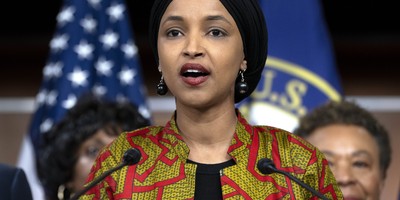In order to win the presidential election next week, President Donald Trump will have to articulate why he is the right choice. The choice has to be about more than Trump and his opponent, former Vice President Joe Biden; it has to be about the very different futures each man would seek to create. The candidates' ability to describe and contrast their visions of the future -- one under Trump and the other under Biden -- will likely prove key to who wins.
This week, we have seen this contrast on full display: the energetic rallies for Trump versus the small, staged events for Biden. The Tuesday-morning edition of The Morning Call newspaper in Lehigh Valley, Pennsylvania, included a front-page picture of Trump at a Pennsylvania rally attended by thousands of his supporters, with a huge grin on his face and the headline "WE GET PA., WE WIN THE WHOLE THING." The secondary article, below the fold, bore the headline "Supporters brave the rain to hear, 'the best president we've had.'"
Biden traveled to Georgia, where he held a rally before about 20 attendees, each of them seated on a chair placed in a circle (to ensure proper social distancing). Video shot along his motorcade route showed that the crowd included Trump supporters who were waving signs in support of the president. It must have been demoralizing to Biden.
The Great Communicator, former President Ronald Reagan, had the ability to lay out a clear contrast between two possible futures, which he honed over decades.
In October 1964, Reagan, in his first national appearance, delivered a 30-minute, nationally televised speech in support of then-Republican candidate Barry Goldwater. This presentation, which later became known as "The Speech," focused on the choice between a government that was intrusive and controlling and one that valued personal freedom and responsibility.
The program was paid for by Goldwater and the Brothers for Goldwater, chaired by John Wayne. It was delivered in front of a studio audience and can be seen today on YouTube.
Recommended
The foundation for this speech had been laid over the previous decade. From 1954 to 1962, Reagan worked for General Electric as a spokesman for its initiative to promote citizenship. GE Vice President Lemuel Boulware believed that "the average citizen cannot afford to leave politics to the politicians." Reagan crisscrossed the country giving speeches to encourage an active citizenry.
The actor promoted conservatism but also talked about the resilience of the American people and the problems that all Americans faced. During his travels, he met thousands of people and learned that, in the end, Americans shared core problems, values and ideals.
Reagan was a uniter. "I believe that the issues confronting us cross party lines," he noted in his October speech.
Instead of separating people into disparate groups, Reagan sought to unite them. He made a compelling case for why we had to work together: "You can't control the economy without controlling the people. We either take responsibility for our own destiny, or we abandon the American revolution and confess that an intellectual belief in a far-distant capital can plan our lives for us better than we can plan them ourselves."
He went on to crush the idea of a boundary between the parties. "You and I are told increasingly we have to choose between a left or right," he said. "Well, I'd like to suggest that there is no such thing as a left or right. There's only an up and down: (up) man's (age-old) dream, the ultimate in individual consistent with law and order, or down to the ant heap of totalitarianism."
While clearly outlining a choice, Reagan differentiated between good motives and bad outcomes. "Regardless of their sincerity, of their humanitarian motives, those who would trade our freedom for security have embarked on this downward course," he said.
When talking about a government that could solve problems through centralization, Reagan noted: "This was the very thing the Founding Fathers sought to minimize. They knew that governments don't control things. A government can't control the economy without controlling people. And they know when a government sets out to do that, it must use force and coercion to achieve its purpose."
Every generation has a rendezvous with destiny, where we can "preserve for our children this last best hope for man on Earth, or we'll sentence them to take the last step into a thousand years of darkness." This next week, we will all have the opportunity to vote on the choice for our future.

























Join the conversation as a VIP Member